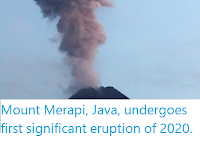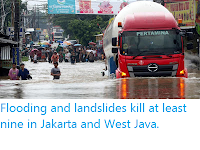Mount Merapi, a volcano in Central Java considered to be one of Indonesia's most active, erupted on Friday 10 April 2020, producing an ash column that rose to about 3000 m above the volcano's 2930 m summit and prompted the Badan Nasional Penanggulangan Bencana to issue a warning to aviation to avoid the area. This is the second major eruption on the volcano this month, the fifth this year, and the thirteenth since the current eruptive phase began in September 2019. Despite the size of this eruption it presents little threat to Human life, as there is already a 3 km radius exclusion zone surrounding the volcano, which the local population, being familiar with the dangers presented by the volcano, are unlikely to flout.
An ash cloud over Mount Merapi, Central Java, on 10 April 2020.
The approximate location of Mount Merapi. Google Maps.
Subduction along the Sunda Trench. Earth Observatory of Singapore.
Follow Sciency Thoughts on Facebook.









